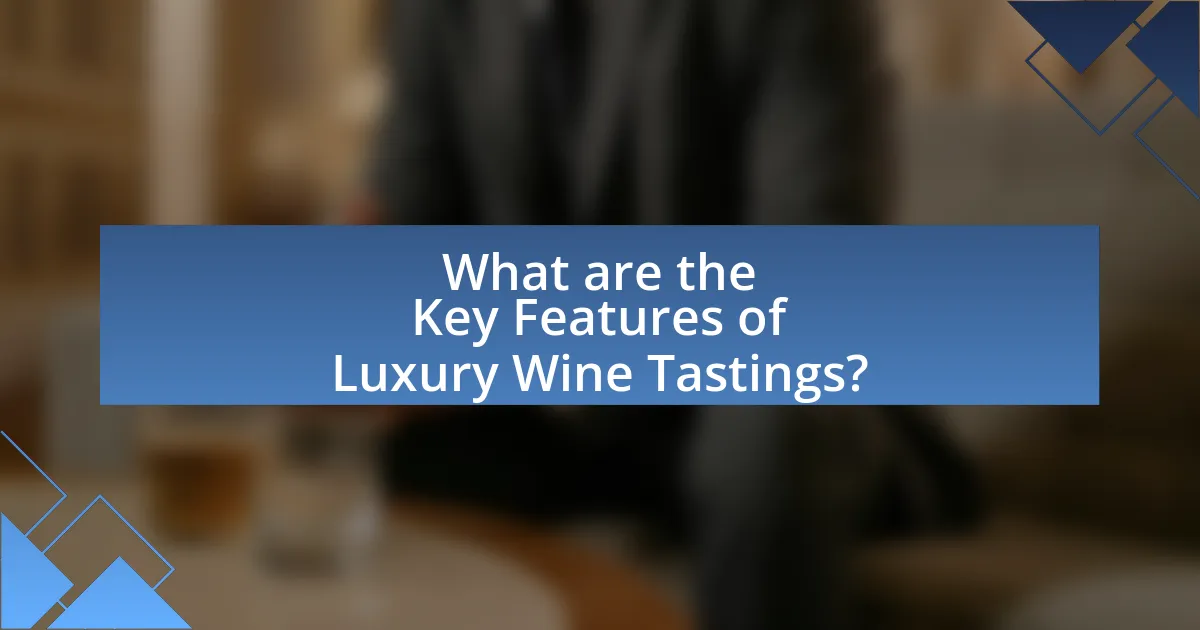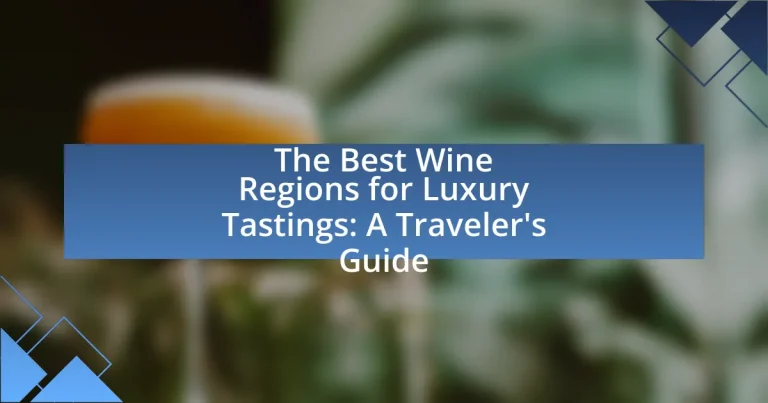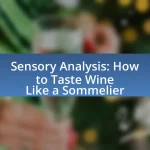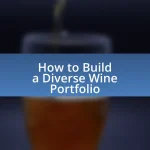The article focuses on the best wine regions for luxury tastings, highlighting Bordeaux in France, Napa Valley in California, Tuscany in Italy, and the Barossa Valley in Australia. It explores how different regions define luxury tastings through exclusive experiences, high-quality wines, and personalized services. Key characteristics of luxurious wine regions, the influence of terroir on wine quality, and the role of expert sommeliers are discussed. Additionally, the article outlines tips for travelers to enhance their luxury wine tasting experiences, including preparation, etiquette, and purchasing considerations.

What are the Best Wine Regions for Luxury Tastings?
The best wine regions for luxury tastings include Bordeaux in France, Napa Valley in California, Tuscany in Italy, and the Barossa Valley in Australia. Bordeaux is renowned for its prestigious châteaux and exceptional red wines, with the region producing some of the most sought-after vintages globally, such as Château Margaux and Château Lafite Rothschild. Napa Valley is famous for its high-quality Cabernet Sauvignon and offers exclusive tastings at renowned wineries like Opus One and Screaming Eagle. Tuscany is celebrated for its iconic Chianti and Brunello di Montalcino, with luxury experiences available at estates like Castello di Ama. The Barossa Valley is known for its rich Shiraz and offers premium tastings at wineries such as Penfolds and Henschke, which have a long history of producing award-winning wines.
How do different wine regions define luxury tastings?
Different wine regions define luxury tastings through unique experiences that emphasize exclusivity, quality, and personalization. For instance, Napa Valley in California often features private vineyard tours and tastings with winemakers, showcasing limited-production wines that are not available to the general public. In Bordeaux, France, luxury tastings may include access to prestigious châteaux and vertical tastings of rare vintages, highlighting the region’s rich history and terroir. Similarly, Tuscany offers luxury experiences that combine wine tasting with gourmet dining and scenic vineyard views, enhancing the overall sensory experience. These definitions of luxury tastings are supported by the regions’ reputations for high-quality wines and the emphasis on creating memorable, tailored experiences for guests.
What characteristics make a wine region luxurious?
A luxurious wine region is characterized by its exceptional terroir, exclusive vineyards, and high-quality wine production. Terroir refers to the unique environmental conditions, including soil, climate, and topography, that influence the grapes’ characteristics, often resulting in premium wines. Exclusive vineyards typically produce limited quantities of wine, enhancing their desirability and prestige. Additionally, luxury wine regions often feature renowned wineries with a history of excellence, such as Bordeaux in France or Napa Valley in California, which are recognized for their award-winning vintages and meticulous winemaking practices. These factors collectively contribute to the perception of luxury in a wine region.
How does the terroir influence luxury wine tastings?
Terroir significantly influences luxury wine tastings by shaping the unique characteristics of the wine through its environmental factors. Terroir encompasses elements such as soil composition, climate, topography, and local traditions, which collectively affect grape growth and flavor profiles. For instance, wines from the Bordeaux region exhibit distinct mineral notes due to the region’s clay and limestone soils, while Napa Valley wines often reflect the warmer climate, resulting in ripe fruit flavors. This relationship between terroir and wine quality is supported by studies indicating that specific terroir attributes can enhance the complexity and depth of luxury wines, making them more desirable during tastings.
Why is wine tasting considered a luxury experience?
Wine tasting is considered a luxury experience due to its association with high-quality wines, exclusive venues, and personalized service. The process often takes place in picturesque vineyards or upscale wineries, where guests can enjoy curated selections of premium wines that are not readily available to the general public. Additionally, wine tastings frequently include expert guidance from sommeliers or winemakers, enhancing the experience with in-depth knowledge about the wines’ origins, production methods, and tasting notes. This combination of exclusivity, ambiance, and expertise elevates wine tasting to a luxury status, appealing to connoisseurs and those seeking unique, indulgent experiences.
What elements contribute to the luxury experience in wine tasting?
The luxury experience in wine tasting is primarily contributed by high-quality wines, exclusive access to vineyards, personalized service, and immersive environments. High-quality wines, often sourced from prestigious regions like Bordeaux or Napa Valley, enhance the tasting experience due to their unique flavors and craftsmanship. Exclusive access to vineyards allows guests to engage in private tours and tastings, often led by winemakers, which adds a personal touch and deeper understanding of the wine. Personalized service, including tailored recommendations and attention to individual preferences, elevates the experience further. Lastly, immersive environments, such as scenic vineyard views or elegant tasting rooms, create a memorable atmosphere that complements the tasting. These elements collectively define the luxury experience in wine tasting.
How do exclusive access and personalized services enhance luxury tastings?
Exclusive access and personalized services significantly enhance luxury tastings by creating unique, tailored experiences that cater to individual preferences. These offerings allow guests to sample rare wines not available to the general public, fostering a sense of exclusivity and privilege. For instance, private vineyard tours often include direct interactions with winemakers, providing insights into the production process and the opportunity to taste limited-edition releases. Research indicates that personalized services, such as customized tasting menus and dedicated sommeliers, increase customer satisfaction and engagement, leading to a more memorable experience. This combination of exclusivity and personalization not only elevates the tasting experience but also strengthens the emotional connection between the consumer and the brand.
Which wine regions are renowned for their luxury offerings?
Bordeaux, Napa Valley, and Burgundy are renowned wine regions for their luxury offerings. Bordeaux, located in France, is famous for its prestigious châteaux and high-quality red wines, with labels like Château Lafite Rothschild and Château Margaux commanding high prices at auctions. Napa Valley, in California, is known for its premium Cabernet Sauvignon and has wineries such as Screaming Eagle and Harlan Estate, which are highly sought after. Burgundy, also in France, is celebrated for its exceptional Pinot Noir and Chardonnay, with top producers like Domaine de la Romanée-Conti producing some of the most expensive wines in the world.
What are the top wine regions known for luxury tastings?
The top wine regions known for luxury tastings are Bordeaux in France, Napa Valley in California, Tuscany in Italy, and the Barossa Valley in Australia. Bordeaux is renowned for its prestigious châteaux and exceptional vintages, with many estates offering exclusive tastings and tours. Napa Valley is famous for its high-quality Cabernet Sauvignon and luxurious winery experiences, often featuring gourmet food pairings. Tuscany, particularly the Chianti and Montalcino areas, is celebrated for its exquisite Sangiovese wines and picturesque vineyard settings, providing intimate tasting experiences. The Barossa Valley is known for its rich Shiraz and offers a range of premium wine experiences, including private tastings at boutique wineries.
How do these regions compare in terms of wine quality and experience?
Regions known for luxury wine tastings, such as Bordeaux, Napa Valley, and Tuscany, exhibit distinct differences in wine quality and experience. Bordeaux is renowned for its complex red blends, particularly Cabernet Sauvignon and Merlot, with a long history of winemaking dating back to Roman times, which contributes to its prestigious reputation. Napa Valley, on the other hand, is celebrated for its innovative winemaking techniques and high-quality Cabernet Sauvignon, often achieving high ratings from critics, with many wineries offering immersive tasting experiences that include vineyard tours and gourmet food pairings. Tuscany is famous for its Sangiovese wines, particularly Chianti, and offers a rich cultural experience with its picturesque landscapes and historic estates, enhancing the overall tasting experience. Each region’s unique terroir, grape varieties, and winemaking traditions significantly influence the quality of the wines produced and the experiences offered to visitors.
What unique experiences can travelers expect in luxury wine regions?
Travelers in luxury wine regions can expect exclusive vineyard tours, private tastings with renowned winemakers, and gourmet dining experiences paired with premium wines. These regions often offer unique activities such as blending workshops, where visitors create their own wine blends, and access to limited-edition releases not available to the general public. Additionally, many luxury wine regions provide accommodations in opulent estates or boutique hotels, enhancing the overall experience with personalized service and stunning views of the vineyards. For instance, Napa Valley in California is known for its high-end wine tours that include helicopter rides over the vineyards, showcasing the landscape while indulging in exquisite wines.
How can travelers choose the right luxury wine region for their preferences?
Travelers can choose the right luxury wine region by assessing their personal taste preferences, desired experiences, and the types of wines they enjoy. For instance, those who favor bold reds may prefer regions like Napa Valley, known for its Cabernet Sauvignon, while those who enjoy crisp whites might opt for the Loire Valley, famous for its Sauvignon Blanc. Additionally, travelers should consider the region’s reputation for luxury experiences, such as exclusive vineyard tours and gourmet dining options, which are prevalent in areas like Bordeaux and Tuscany. Research indicates that regions with a strong focus on wine tourism, such as Sonoma County, often provide tailored experiences that enhance the overall enjoyment of wine tasting.

What are the Key Features of Luxury Wine Tastings?
Key features of luxury wine tastings include exclusive access to rare wines, personalized service, and immersive experiences that often involve vineyard tours and food pairings. Exclusive access allows participants to sample limited-edition or vintage wines not available to the general public, enhancing the tasting experience. Personalized service typically involves knowledgeable sommeliers or wine experts who guide guests through the tasting process, providing insights into the wines’ origins and characteristics. Immersive experiences may include guided tours of vineyards, where guests learn about the winemaking process, and curated food pairings that complement the wines, elevating the overall tasting experience. These features collectively create a unique and memorable luxury wine tasting event.
What types of wines are typically featured in luxury tastings?
Luxury tastings typically feature high-end wines such as Bordeaux, Burgundy, Champagne, and Barolo. These wines are renowned for their quality, complexity, and aging potential, often sourced from prestigious vineyards and regions. For example, Bordeaux wines, particularly those from classified growth estates, are celebrated for their rich flavors and structured tannins, while Burgundy wines are prized for their terroir-driven characteristics. Champagne, known for its sparkling quality, is often included for its celebratory nature and craftsmanship. Barolo, often referred to as the “King of Wines,” showcases the Nebbiolo grape’s depth and elegance. These selections reflect the pinnacle of winemaking and are sought after by connoisseurs and collectors alike.
How do vintage and rarity affect the luxury wine selection?
Vintage and rarity significantly influence luxury wine selection by determining both the perceived quality and exclusivity of the wine. Wines from exceptional vintages, such as 1945 Bordeaux or 1990 Champagne, are often sought after due to favorable growing conditions that enhance flavor profiles and aging potential. Rarity further elevates a wine’s status; limited production wines, like those from cult wineries, can command higher prices and desirability among collectors. For instance, a rare bottle of Screaming Eagle Cabernet Sauvignon can sell for thousands of dollars at auction, reflecting both its limited availability and the acclaim of its vintage. Thus, the interplay of vintage and rarity creates a framework that drives luxury wine selection, making certain bottles more coveted and valuable in the market.
What role do expert sommeliers play in luxury tastings?
Expert sommeliers play a crucial role in luxury tastings by providing expert guidance on wine selection, enhancing the overall tasting experience. They possess extensive knowledge of wine regions, varietals, and vintages, allowing them to curate exceptional wine pairings that complement the culinary offerings. Their expertise ensures that guests receive personalized recommendations tailored to their preferences, which elevates the tasting to a more sophisticated level. Additionally, sommeliers often share insights about the wine’s origin, production methods, and tasting notes, enriching the educational aspect of the experience. This combination of personalized service and in-depth knowledge is essential in luxury tastings, where the goal is to create a memorable and immersive experience for participants.
What amenities and services enhance the luxury tasting experience?
Luxury tasting experiences are enhanced by exclusive amenities and personalized services such as private tastings, gourmet food pairings, and access to limited-edition wines. Private tastings allow guests to enjoy tailored experiences with expert sommeliers, providing in-depth knowledge about the wines. Gourmet food pairings elevate the tasting by complementing the flavors of the wines, often featuring locally sourced ingredients. Access to limited-edition wines offers guests the opportunity to sample rare selections that are not available to the general public, adding a unique aspect to the experience. These elements collectively create an immersive and memorable luxury tasting environment.
How do gourmet food pairings complement luxury wine tastings?
Gourmet food pairings enhance luxury wine tastings by elevating the sensory experience and highlighting the wine’s unique characteristics. When high-quality food is paired with premium wines, the flavors can interact, creating a more complex and enjoyable tasting experience. For instance, a rich, buttery Chardonnay can be complemented by a creamy lobster dish, allowing the wine’s acidity to balance the dish’s richness. This synergy not only enhances the flavors of both the food and the wine but also allows tasters to appreciate the nuances of the wine more fully. Studies in gastronomy have shown that specific food and wine pairings can enhance the perception of taste, making the overall experience more memorable and satisfying.
What exclusive tours and events are available in luxury wine regions?
Exclusive tours and events in luxury wine regions include private vineyard tours, exclusive wine tastings, and gourmet dining experiences. For instance, in Napa Valley, visitors can participate in private tastings at renowned wineries like Opus One, where they can sample limited-edition wines not available to the public. Additionally, regions such as Bordeaux offer bespoke tours that include access to historic châteaux and the opportunity to meet winemakers. These experiences often feature gourmet meals paired with premium wines, enhancing the luxury aspect. Such exclusive offerings are designed to provide an intimate and personalized experience, catering to wine enthusiasts seeking unique and high-quality interactions with the wine culture.
How do luxury wine tastings differ from standard tastings?
Luxury wine tastings differ from standard tastings primarily in the exclusivity and quality of the wines offered. Luxury tastings typically feature rare, high-end wines that are often sourced from prestigious vineyards, while standard tastings may include more widely available and less expensive options. For example, luxury tastings may include vintages that are not available to the general public, showcasing limited releases or award-winning selections. Additionally, luxury tastings often provide a more personalized experience, including private tours, expert sommeliers, and gourmet food pairings, enhancing the overall sensory experience. This distinction is supported by the fact that luxury wine experiences are often held in renowned wine regions, such as Bordeaux or Napa Valley, where the focus is on creating an immersive and educational environment for discerning wine enthusiasts.
What are the key differences in the tasting process?
The key differences in the tasting process include the focus on sensory evaluation, the environment in which tastings occur, and the level of expertise of the tasters. Sensory evaluation emphasizes the assessment of aroma, flavor, and texture, which can vary significantly based on the wine’s origin and varietal characteristics. The environment, such as a vineyard versus a tasting room, influences the overall experience, as natural settings can enhance sensory perception. Additionally, the expertise of tasters, ranging from novices to sommeliers, affects the depth of analysis and appreciation of the wine, with trained professionals often identifying subtleties that casual drinkers may overlook.
How does the atmosphere contribute to the luxury experience?
The atmosphere significantly enhances the luxury experience by creating an immersive environment that engages the senses. In luxury wine regions, elements such as scenic landscapes, elegant architecture, and curated interior designs contribute to a feeling of exclusivity and comfort. For instance, vineyards with breathtaking views and meticulously designed tasting rooms elevate the overall experience, making it memorable. Research indicates that sensory stimuli, including visual aesthetics and ambient sounds, can influence perceptions of quality and satisfaction, reinforcing the notion that a well-crafted atmosphere is essential for luxury experiences.

What Tips Should Travelers Consider for Luxury Wine Tastings?
Travelers should consider booking tastings in advance to secure spots at exclusive wineries. Many luxury wine tastings require reservations due to limited availability and high demand, especially in renowned regions like Napa Valley and Bordeaux. Additionally, travelers should research the wineries to understand their offerings and select those that align with their preferences, such as specific varietals or vineyard tours. Engaging with knowledgeable staff during tastings enhances the experience, as they can provide insights into the wine-making process and the history of the vineyard. Finally, travelers should consider transportation options, such as hiring a driver or joining a guided tour, to fully enjoy the tastings without the concern of driving.
How can travelers prepare for a luxury wine tasting experience?
Travelers can prepare for a luxury wine tasting experience by researching the specific wineries they plan to visit and making reservations in advance. This preparation ensures access to exclusive tastings and knowledgeable guides who can enhance the experience. Additionally, understanding the types of wines produced in the region, such as Napa Valley’s Cabernet Sauvignon or Bordeaux’s Merlot, allows travelers to appreciate the nuances of each selection. Dressing appropriately for the venue and considering transportation options, such as hiring a driver, further elevates the experience by ensuring comfort and safety.
What should travelers wear to a luxury wine tasting event?
Travelers should wear smart casual attire to a luxury wine tasting event. This typically includes tailored trousers or a chic dress, paired with stylish shoes, and accessories that reflect sophistication. The smart casual dress code is appropriate as it balances elegance with comfort, allowing attendees to enjoy the experience without feeling overdressed or underdressed. Many luxury wine tasting venues emphasize a refined atmosphere, making it essential for guests to present themselves in a manner that aligns with the upscale setting.
How can travelers maximize their enjoyment during tastings?
Travelers can maximize their enjoyment during tastings by engaging fully with the experience, which includes asking questions, savoring each sip, and taking notes. Engaging with staff enhances understanding of the wine’s background, while savoring allows for appreciation of flavors and aromas. Taking notes helps in recalling preferences and details for future reference. Research indicates that active participation in tastings leads to a more enriching experience, as it fosters a deeper connection to the wines and the regions they come from.
What are common pitfalls to avoid during luxury wine tastings?
Common pitfalls to avoid during luxury wine tastings include overindulgence, neglecting to cleanse the palate, and failing to engage with the wine’s characteristics. Overindulgence can lead to impaired judgment, making it difficult to appreciate the nuances of each wine. Neglecting to cleanse the palate between tastings can result in flavor contamination, diminishing the tasting experience. Additionally, failing to engage with the wine’s characteristics, such as aroma and texture, can prevent a full understanding of the wine’s quality and complexity. These practices are essential for a refined tasting experience, as they enhance appreciation and understanding of luxury wines.
How can travelers ensure they respect the tasting etiquette?
Travelers can ensure they respect tasting etiquette by adhering to local customs and guidelines during wine tastings. This includes arriving on time, being polite to staff, and following specific tasting protocols such as swirling, sniffing, and sipping the wine appropriately. Additionally, it is important to refrain from excessive commentary or criticism about the wines being tasted, as this can be seen as disrespectful. Understanding and observing the cultural norms of the wine region, such as dress codes or specific rituals, further demonstrates respect for the experience and the hosts.
What should travelers know about wine purchasing after tastings?
Travelers should know that purchasing wine after tastings often involves understanding the winery’s shipping policies and state regulations. Many wineries offer direct shipping options, but laws vary by state regarding the shipment of alcohol, which can affect delivery. Additionally, travelers should consider buying wines that are exclusive to the winery or limited in production, as these selections often provide a unique experience that cannot be found elsewhere. Furthermore, it is advisable to inquire about discounts for purchasing multiple bottles, as many wineries offer incentives for bulk purchases.
What resources are available for planning luxury wine tasting trips?
Luxury wine tasting trips can be planned using various resources, including specialized travel agencies, wine tour operators, and online platforms dedicated to wine tourism. These agencies often provide curated itineraries that include exclusive vineyard access, private tastings, and gourmet dining experiences. Websites like Wine.com and Vivino offer user reviews and recommendations for wineries, while apps such as CellarTracker help track wine preferences and suggest tasting experiences. Additionally, travel guides focused on wine regions, such as “The Wine Bible” by Karen MacNeil, provide in-depth insights into the best vineyards and tasting opportunities, ensuring a well-informed planning process.


